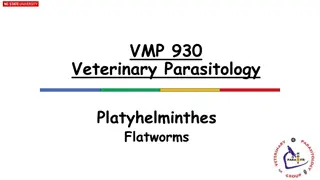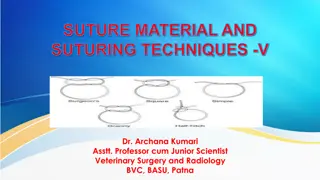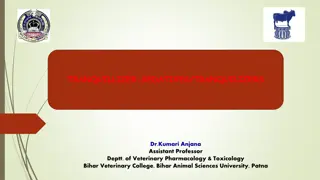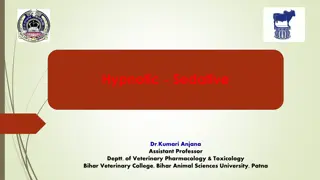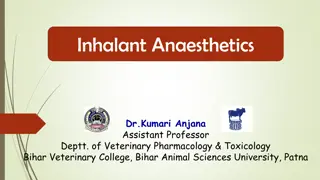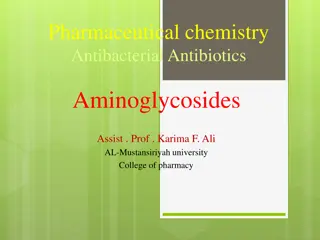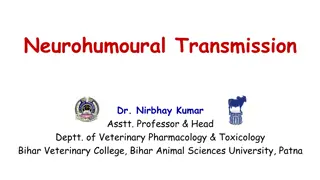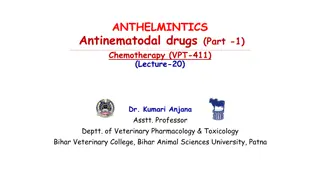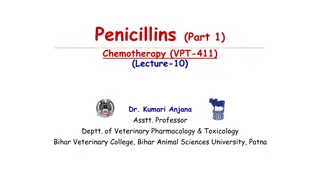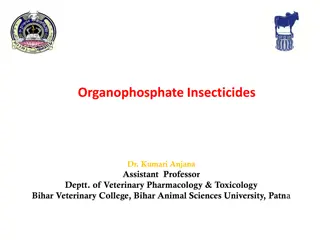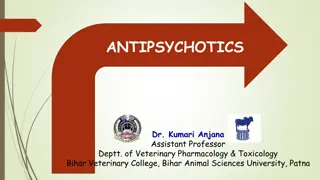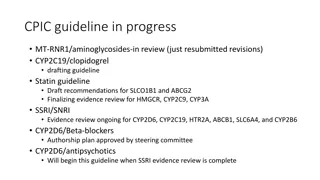Understanding Aminoglycosides in Veterinary Pharmacology
Aminoglycosides are a crucial group of antibiotics in veterinary medicine, known for their bactericidal properties and shared chemical characteristics. This class of drugs has a rich history, with members like streptomycin, neomycin, kanamycin, gentamicin, and amikacin. Chemistry-wise, aminoglycosides consist of amino sugars linked to a hexose nucleus, imparting basic nature and water solubility. Minor structural variations can impact efficacy and toxicity. Produced by soil actinomycetes, these antibiotics are essential in combating bacterial infections in animals.
Download Presentation

Please find below an Image/Link to download the presentation.
The content on the website is provided AS IS for your information and personal use only. It may not be sold, licensed, or shared on other websites without obtaining consent from the author. Download presentation by click this link. If you encounter any issues during the download, it is possible that the publisher has removed the file from their server.
E N D
Presentation Transcript
Aminoglycosides Chemotherapy (VPT-411) (Lecture-13) Dr. Kumari Anjana Asstt. Professor Deptt. of Veterinary Pharmacology & Toxicology Bihar Veterinary College, Bihar Animal Sciences University, Patna
Content of the chapter Aminoglycosides Introduction, History Source chemistry, classification spectrum of activity MOA Applications Side effects
Introduction Aminoglycosides are a group of natural and Semisynthetic antibiotics which contain amino sugars linked to aminocyclitol ring by glycosidic bond. They are mostly bactericidal and share many chemical and pharmacological properties. Similar antibacterial spectrum and toxic effect.
History Streptomycin - the first member of aminoglycoside antibiotics discovered in 1944 by Waksman and co-workers from a strain of Streptomyces griseus. Neomycin was next to be isolated in 1949 kanamycin is 1957 and gentamicin in 1963. Amikacin was the first semi-synthetic aminoglycoside obtained by chemical modification of kanamycin. Now aminoglycosides have many extensively used in veterinary medicine. members, some of which are
Chemistry The aminoglycosides consist of two or more amino sugars joined in glycosidic linkages to a hexose (aminocyclitol) nucleus. In streptomycin, the hexose molecule is 2-deoxystreptamine. The presence of amino group in the structure imparts basic nature and the hydroxyl group on the sugars provide high water solubility (or poor lipid solubility) to the drugs.
If these hydroxyl groups are removed (e.g., tobramycin), the drug becomes more active. Because the groups can be substituted at more than one positions on the molecule, aminoglycoside may be obtained. several forms of same For example, neomycin is a mixture of neomycin B, C, and and gentamicin is a complex of gentamicins C1, C1a, and C2.
Minor differences in the chemical structures of these drugs may lead to differences in efficacy and toxicity. All aminoglycosides are produced by the soil actinomycetes. While most aminoglycosides are obtained by natural fermentation of various species of Streptomyces, some members of the group (e.g., gentamicin) are prepared from the actinomycetes Micromonospora. Aminoglycosides prepared from Streptomyces carry the suffix mycin, Micromonospora have name ending with micin.
Classification Based on antibacterial spectrum: Narrow spectrum: oStreptomycin and dihydrostreptomycin. oMainly active aerobic Gram negative bacteria (E.coli, Salmonella, pasturella spp. Brucella spp.) and also against Staphylococci, Actinomyces bovis and Laptospira spp. o Mycobacterium tuberculosis is sensitive to streptomycin.
Broad spectrum: o Gentamicin, tobramycin, Amikacin, sisomicin and netilmicin. oHighly effective against a wide variety of aerobic (both Gram positive and Gram negative) bacteria including Pseudomonas aeroginosa. oGentamicin is more potent than streptomycin (MIC 4-8 times lower), but it is ineffective against M. tuberculosis. oAmikacin and netilmicin are resistant to bacterial aminoglycoside inactivating enzymes and therefore have widest spectrum of activity including against organisms resistant to other aminoglycosides.
Extended spectrum: oNeomycin, framycetin, paromomycin and Kanamycin. oThey have broader spectra than streptomycin and effective against both aerobic gram-negative bacteria as well as against several Gram positive bacteria. oThey are clinically most useful against Gram negative infections caused by E.coli, Salmonella, Klebsiella and Enterobacter.
Miscellaneous: oAparamycin and spectinomycin. oThese drugs are structurally somewhat different from typical aminoglycosides, but spectra and mechanism of action. have similar antibacterial
Source Streptomycin: Streptomyces griseus; Neomycin: S. Fradiae; Kanamycin: S. kanamyceticus; Gentamicin: Micromonospora Purpurea; Tobramycin: S. tenebrarius; Amikacin: Semisynthetic derivative of Kanamycin; Sisomicin: Micromonospora inyoensis; Netilmicin: Senmisynthetic derivative of sisomicin; Framycetin: S. Lavendulae.
Common Properties of Aminoglycosides All are used as sulphate salts that are highly water soluble (stable). None is absorbed after oral administration as they are polycations. None penetrate the brain or CSF. All are rapidly excreted unchanged through normal kidney by glomerular filtration. They are exclusively used in the treatment of Gram negative bacterial infections.
All act by interference with the protein synthesis in susceptible bacteria. They are bactericidal and more active at alkaline pH. Partial cross resistance may be seen among them. They have relatively narrow margin of safety. All share common toxicities (ototoxicity and nephrotoxicity).
Mechanism of action The aminoglycosides are bactericidal antibiotics, all having the same general pattern of action which may be described in two main steps: 1. Transport of the aminoglycoside through the bacterial cell wall and cytoplasmic membrane. 2. Binding to ribosome resulting in inhibition of protein synthesis.
Step I Transport of aminoglycoside into bacteria: It is a multistep process. They diffuse across the outer coat of gram-negative bacteria through porin channels. Entry from the periplasmic space across the cytoplasmic membrane is carrier mediated which is linked to the electron transport chain. Thus, penetration is dependent upon maintenance of a polarized membrane and on oxygen dependent active processes.
These processes inactivated under anaerobic conditions; anaerobes are not sensitive and facultative anaerobes are more resistant when o2supply is deficient, e.g. inside big abscesses. Penetration is also favored by high pH; aminoglycosides are - 20 times more active in alkaline than in acidic medium. Bacterial enhance entry of aminoglycosides and exhibit synergism. cell wall inhibitors ( -lactams, Vancomycin)
Step II Once inside the bacterial cell, streptomycin binds to 30S ribosomes, but other aminoglycosides bind to additional sites on 50S subunit, as well as to 30S-50S interface. They freeze initiation of protein synthesis, prevent polysome formation and promote their disaggregation to monosomes so that only one ribosome is attached to each strand of mRNA.
Binding of aminoglycoside to 30S-50S juncture causes distortion of mRNA codon recognition resulting in misreading of the code: one or more wrong amino acids are entered in the peptide chain and /or peptides of abnormal length are produced. Different aminoglycosides cause misreading at different levels depending upon their selective affinity for specific ribosomal proteins.
Cidal action of Aminoglycoside The cidal action - based on secondary changes in the integrity of bacterial cell membrane, Other antibiotics which inhibit protein synthesis (tetracyclines, chloramphenicol, erythromycin) are only static. After exposure to aminoglycosides, sensitive bacteria become more permeable; ions amino acids and even proteins leak out followed by cell death. This probably result from incorporation of the defective proteins into the cell membrane. This reinforces the lethal action.
The cidal action of aminoglycosides is concentration dependent, i.e. rate of bacterial cell killing is directly related to the ratio of the peak antibiotic concentration to the MIC value. They postantibiotic effect . also exert a long and concentration dependent Despite their short t1/2 (2-4 hr), single injection of the total daily dose of aminoglycoside may be more effective and possibly less toxic than its conventional division into 2-3 doses.
Pharmacokinetics Aminoglycosides are poorly or not absorbed from the GI tract but absorption from IM site is rapid and complete (peak plasma conc. by 1 hr). They distribute only into the extracellular fluid with minimum penetration to most of the tissues except the kidney (nephrotoxicity) and the endolymph of the internal ear (ototoxicity). They show low tendency to bind with plasma proteins and effective levels are not reached in CSF and milk. These antibiotics are not metabolized in the body of the animals and are mainly eliminated unchanged in urine by Glomerular filtration.
Clinical Uses Aminoglycosides are commonly used in several local and systemic infections caused by susceptible aerobic bacteria (particularly Gram negative bacteria). Streptomycin is widely used for the treatment of bovine streptococcal and staphylococcal mastitis (Strepto-penicillin as oily intrammary infusion), pasteurellosis E-coli infection (causing mastitis, metritis, enteritis and septicemia in all species), leptospirosis (for clearance of organism from urine), tuberculosis and vibriosis.
Gentamicin -- parenterally used in the treatment of Gram negative septicemia (drug of choice), urinary tract, GI tract, respiratory tract and topically in eye/ear infections. Framycetin -- rarely used systemically because of ototoxicity and nephrotoxicity but used for the treatment of enteritis and topically for otitis externa in dogs. Netilmicin - is resistant to bacterial aminoglycoside inactivating enzymes and thus effective against gentamicin resistant strains.
Adverse reactions and Toxicity The aminoglycosides produce toxic effect which is common to all but the relative intensity may differ. The main toxicities are: Ototoxicity Nephrotoxicity Neuromuscular blockade
Ototoxicity This is the most related to dose and duration of treatment . The ototoxicity involves ---progressive and irreversible damage to and destruction sensory cells in the cochlea and vestibular apparatus of the internal ear. Vestibular damage - nystagmus, vertigo and ataxia. Cochlear damage -- auditory disturbances which may even lead to deafness. the
Other ototoxic drugs potentiates the ototoxicity of aminoglycosides. Cats are particularly sensitive to vestibular toxicity. Streptomycin and Gentamicin are more prone to produce vestibular toxicity. Neomycin and amikcacin cause mainly cochlear damage. Netilmicin is less ototoxic and therefore preferred for long term use.
Nephrotoxicity It is due to damage of kidney tubules and this is more common in patient with preexisting kidney diseases. Renal damage can be reversed by immediate discontinuation of drugs.
Neuromuscular blockade High doses of aminoglycosides may cause neuromuscular blockade (due to chelation of calcium and reduction of Ach release from the motor nerve endings by aminoglycosides) resulting in skeletal muscle paralysis and respiratory arrest which may even lead to death. Neomycin and streptomycin are more prone to cause this toxic effect than Kanamycin, Gentamicin or Amikacin. Tobramycin is least toxic in this respect. The blockade can be partially antagonized by IV calcium gluconate and neostigmine. Neuromuscular blockers should be used cautiously in animals receiving aminoglycoside antibiotics.
Hypersensitivity reactions Contact dermatitis and sometime allergic reaction particularly to streptomycin is common. Rapid IV injection: At high dose may cause CNS disturbances, even convulsions, respiratory arrest, fall in BP, collapse and death.
Contraindications and precautions Contraindications and precautions: To be avoided during pregnancy (fetal toxicity), along with other ototoxic drugs (high ceiling diuretics, minocycline) To be avoided with other nephrotoxic drugs (amphotericin B, cephaloridine etc). Neomycin is contraindicated in animals prone to post-perturient hypocalcaemia
Dosages of Aminoglycosides Streptomycin and dihydrostreptomycin: Oral: 20 mg/kg 2-3 times in a day; IM: 8-12 mg/kg twice a day; Intramammay @ 100 mg/quarter (in dry cows). Gentamicin: 3-6 mg/kg IM or SC 2-3 times a day Kanamycin: 12-15 mg/kg IM or SC twice a day Amikacin: 5-7.5 mg/kg. IM or SC once or twice daily Netilmicin: 3-6 mg/kg, IM or SC once or twice daily. Neomycin: Oral 20 mg/kg thrice a day; Intramammary @ 0.5-1 gm/quarter daily.
Drug withdrawal time Drug withdrawal time for aminoglycoside antibiotics: oral dosing: 20-30 days; parenteral; 100-200 days and 2-3 days after interamammary administration (Usually not approved for use in food animals).
Spectinomycin An aminocyclitol antibiotic produced by Streptomyces spectabilis. It is active against several Gram +Ve organisms (used as alternative to Penicillin G), a wide range of Gram negative bacteria and Mycoplasma species. It inhibits the protein synthesis in these organisms by binding with 30s ribosome and produces a bacteriostatic rather than bactericidal effect.
It is poorly absorbed from GI tract but rapidly absorbed after IM administration. The antibiotic is mainly used in the treatment of CRD and fowl cholera in poultry, colibacillosis in pigs and poultry and E.coli mastitis in cows.
Apramycin It is a Bactericidal antibiotic. Mainly used to control Gram negative infections, especially E.coli and Salmonella infections in calves and piglets. It is also active against Proteus, Klebsiella, Treponema and Mycoplama species.
It is not absorbed orally but rapidly absorbed parenterally. The drug is contraindicated in cats because of its severe toxic action, but it can be given safely to other animals. It is used in the treatment of colibacillosis and salmonellosis in calves and piglets.
Summary Streptomycin - the first member of aminoglycoside antibiotics discovered in 1944 by Waksman and co-workers from a strain of Streptomyces griseus. The aminoglycosides are bactericidal antibiotics, all having the same general pattern of action. Bactericidal and more active at alkaline pH. The cidal action - based on secondary changes in the integrity of bacterial cell membrane.





